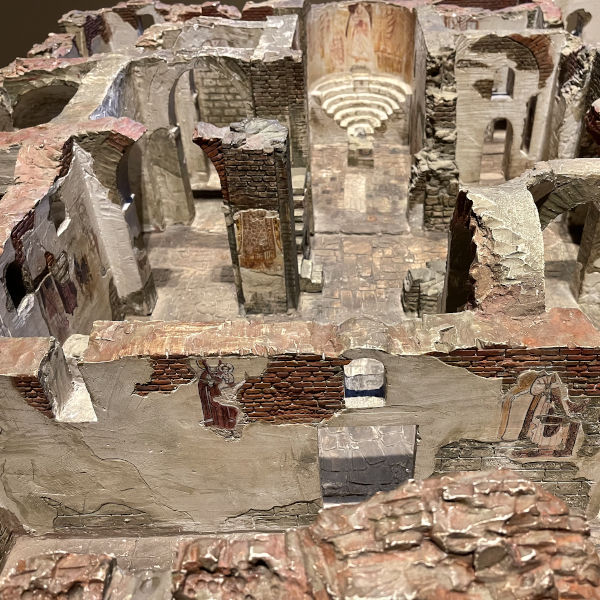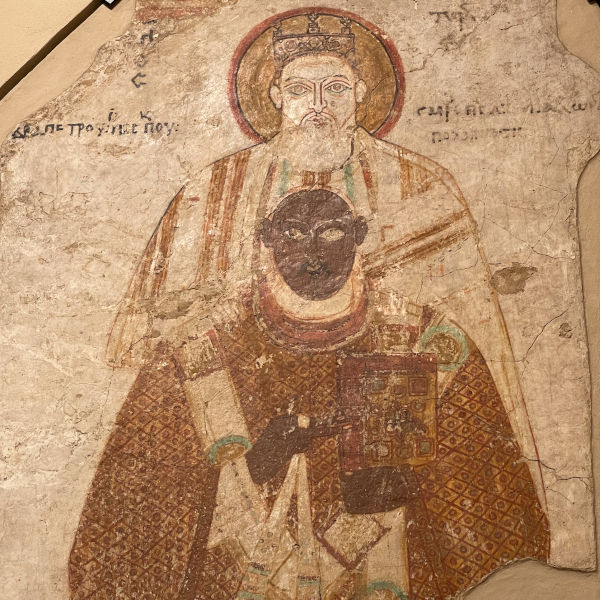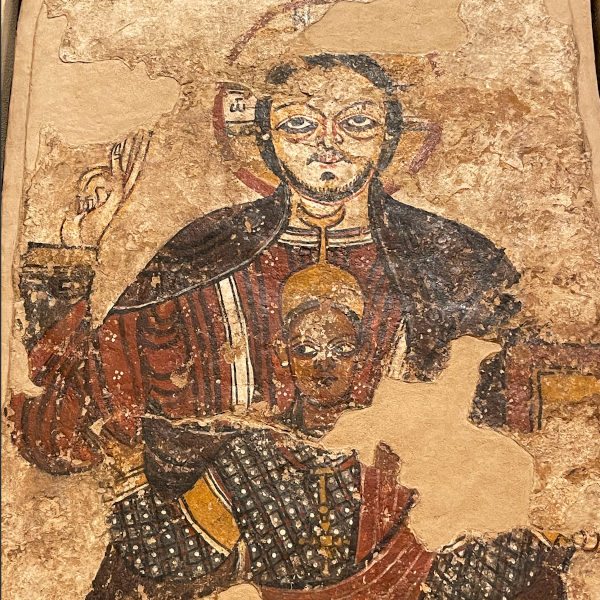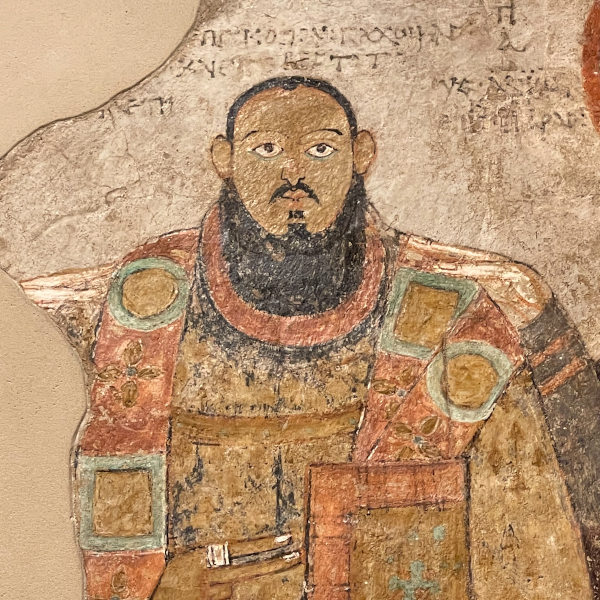DNA spotlight
Kingdom of Makuria

Faras was a major city located in Lower Nubia along the Nile River near the border of modern Egypt and Sudan. Following the collapse of the Kingdom of Kush, the nomadic Noba people settled into the area - this is the origin of the term Nubia. In 543 AD, the city adopted Christianity after encountering a mission dispatched by Byzantine Empress Theodora. The cathedral shown here was founded by bishop Aetious in 620 AD. The paintings found therein are the best surviving examples of Christian Nubian art, as well as depict portraits of monarchs and bishops providing us a treasure trove of historical evidence regarding this period of Medieval Nubia. The inscriptions record the names and dates of the 30 Bishops and Metropolitans of the Diocese from 620 AD to 1372 AD.

Shown here is Bishop Petros with Saint Peter the Apostle. This mud plaster is dated between 957-999 AD and is considered one of the best portraits found in Faras. The dark-skinned bishop is wearing his liturgical robes with a white handkerchief wrapped around the index finger of his right palm which points at a Gospel Book. His long white robe has vertical green stripes his vestments are adorned with green and red jewels. His head is wrapped in a turban typical of the Coptic Church hierarchs. The greek inscription above states: Saint Peter the Apostle Martyr of the Cross Abba Petros Bishop and Metropolitan of Pachoras may he live many years. The portrait originally appeared as part of a larger composition next to King Georgious II of Makuria.

This striking image produced on mud plaster shows Christ and a young Nubian ruler and dates to the mid 12th century AD. It was discovered on the southern chapel at Faras. The Makurian Kings ruled from Dongola which became the capital in the mid 6th century with the arrival of Christianity. Initially there were several independent kingdoms which gradually merged into a single one over time. The throne room located in Dongola has provided some information as to the names of these kings but archaeological work remains underway today in the region to uncover this lost history. The Nubian ruler shown here has not yet been identified but based on the dating could be related to King Georgios V who ruled a single united kingdom from 1130-1155 AD.

This image depicts Bishop Marianos and dates between 1005-1039 AD. This is one of the most beautiful and well-preserved portraits of ecclesiastical officials in Nubia. Marianos was bishop of Faras between 1005-1036 AD and is shown as a middle-aged man with a dark, wide and short beard. He is wearing flamboyant liturgical vestments. This portrait was discovered on the eastern wall of the Southern Chapel and found alongside images of other Nubian clergymen. In 1964 the cathedral of Faras disappeared forever under the rising waters of Lake Nubia. Of the 169 uncovered paintings found in the sands of Sudan, 120 were recovered with 67 on display in the Polish National Museum / Faras Gallery in Warsaw - thanks to the generous efforts of Wojciech Pawlowski - and the remainder on display in the Sudan National Museum in Khartoum.
Sample: Kulubnarti Makurian Nubia
- Sample ID: I6256
- Year: 810 AD
- Sex: Female
- Location: 21.070833,30.663889
Sample: Kulubnarti Makurian Nubia
- Sample ID: I6257
- Year: 810 AD
- Sex: Male
- Location: 21.070833,30.663889
Sample: Kulubnarti Early Makurian Nubia
- Sample ID: I18508
- Year: 750 AD
- Sex: Male
- Location: 21.070833,30.663889
Sample: Kulubnarti Early Makurian Nubia
- Sample ID: I18509
- Year: 750 AD
- Sex: Female
- Location: 21.070833,30.663889
Sample: Kulubnarti Early Makurian Nubia
- Sample ID: I18510
- Year: 750 AD
- Sex: Female
- Location: 21.070833,30.663889
Sample: Kulubnarti Early Makurian Nubia
- Sample ID: I18511
- Year: 750 AD
- Sex: Female
- Location: 21.070833,30.663889
Sample: Kulubnarti Early Makurian Nubia
- Sample ID: I18514
- Year: 750 AD
- Sex: Male
- Location: 21.070833,30.663889
Sample: Kulubnarti Early Makurian Nubia
- Sample ID: I18517
- Year: 750 AD
- Sex: Female
- Location: 21.070833,30.663889
Sample: Kulubnarti Early Makurian Nubia
- Sample ID: I18518
- Year: 750 AD
- Sex: Female
- Location: 21.070833,30.663889
Sample: Kulubnarti Early Makurian Nubia
- Sample ID: I18519
- Year: 750 AD
- Sex: Female
- Location: 21.070833,30.663889
Sample: Kulubnarti Early Makurian Nubia
- Sample ID: I18520
- Year: 750 AD
- Sex: Male
- Location: 21.070833,30.663889
Sample: Kulubnarti Early Makurian Nubia
- Sample ID: I18521
- Year: 750 AD
- Sex: Female
- Location: 21.070833,30.663889
Sample: Kulubnarti Early Makurian Nubia
- Sample ID: I18522
- Year: 750 AD
- Sex: Female
- Location: 21.070833,30.663889
Sample: Kulubnarti Early Makurian Nubia
- Sample ID: I18525
- Year: 750 AD
- Sex: Female
- Location: 21.070833,30.663889



